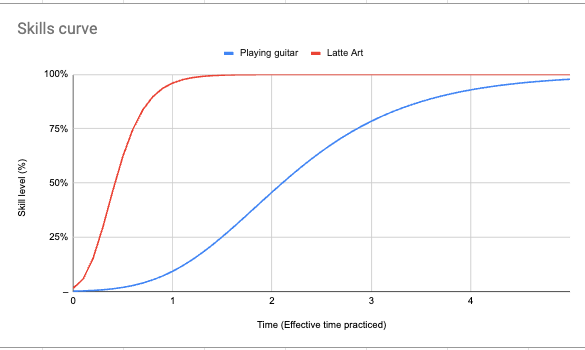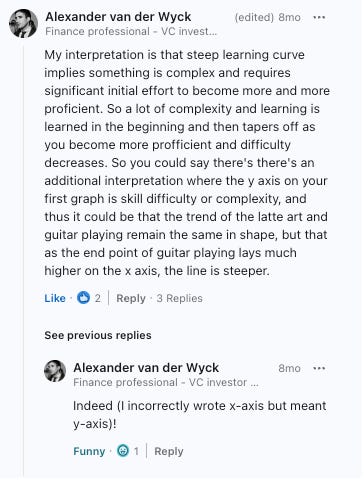The unifying theory of the learning curve concept
This is a repost from something I posted on LinkedIn that I revisited in the context of my learning to code journey. Here is an updated version of it.
I posted this on LinkedIn a while back
Random pet peeve I remembered after listening to a podcast: Most people use the word 'learning curve' wrong. If time is on the x-axis and skill on the y-axis, a steep learning curve means learning is fast. Most people say the learning curve is steep when they mean that something is difficult to learn. But actually, when something is difficult to learn, it takes a lot of time to learn so the learning curve is shallow.
It triggered an unexpected discussion in the comments.
I learned that the common interpretation of the learning curve concept is something like 'being forced to learn something very fast'. I thought about this a bit more, and decided to try and unify the two interpretations (potentially not the most valuable use of my Monday night, but anyway).
How I always interpreted "steep learning curve"
Imagine identical twins: Harry and Larry. Tomorrow, they will dedicate their life to learning a new skill each. Harry will learn to play guitar and Larry will learn to make Latte Art. They will approach this with a life-or-death seriousness and dedicate all their waking hours to learning these crafts. Up until this point in their life they have done everything exactly the same. One is not more talented or educated than the other in any way. If they would switch skills, the curves would still look exactly the same.
Plotting 'Time' and 'Skill' in a graph, the learning curve visualizes the level of skill the twins acquire over time. Latte art and playing guitar are both hard skills with a learning curve. But playing guitar takes significantly more practice than making Latte Art. Larry is already pouring beautiful latte hearts while Harry is still struggling with Wonderwall.
Therefore, the learning curve for Latte Art is steeper than the one for learning guitar.
I will call this the Skill Curve. The hidden assumption is that you will work with full dedication on progressing through the curve. The time dimension is not days, not months or even hours, but something like 'effective hours practice'.
Something (a skill) HAS a steep learning curve (competence grows quickly, i.e. it is easy)How most people interpret "steep learning curve"
Another pair of identical twins, Alice and Clarissa, are interested in learning Latte Art. Alice watches a youtube video and starts making two lattes per day for herself in the morning. Clarissa takes a job as a Barista and starts making 50 lattes per day. She is under constant fire from her customers who want nice looking hearts instead of her shapeless blobs. Clarissa is exhausted at the end of her shift. She watches everything about Latte Art on youtube she can find, and spends the night making 10 more Lattes at home. She gets better quickly. Soon she's making intricate autumn leave patterns while Alice is still struggling to make a heart.
Clarissa experiences a much steeper learning curve. The hidden assumption in this interpretation is:
Someone (a person) FACES a steep learning curve (they have to learn a lot quickly) There is yet a third interpretation
So Alexander is saying that different skills flatten out at different points on the y-axis. Therefore, when someone says the learning curve is steep, they mean there is more to learn to get to a point of even some competence.
In the case of latte art, the first attempts are going to be a total disaster. There is a lot to learn at first: the right way to froth the milk, pouring angle, height, consistency. Only when all of these start coming together does Latte art begin to emerge.
The same is true for playing guitar. Chord shapes, notes on the neck, willing your fingers to move to the right place, battling painful fingertips, strumming. Only when all that comes together, does even something as easy as “Wonderwall” begin to emerge. But with Latte art, there aren’t really 500 more levels. There is no need to do it wrong-handed, upside down, or whatever (I can’t even think of a good analogy). With guitar, there is flat picking, finger style, sweep picking, finger style, tapping, lead playing. There are a lot more skill points to earn.
I had to think about what Alex meant mathematically for quite some time, but I think it takes time completely out of the equation. Instead, we should chart ‘Skill points’ against ‘Skill level’.
In this interpretation, it is indeed the case that a more difficult skill has a steeper learning curve
A skill HAS a steeper learning curve simply if there is more to learn, btw we are not considering time at all here.Unifying the theories of learning curves
If I really wanted to prove myself right (and I do like to be right) I would do it with this argument:
The time dimension should be the work you put into learning.
Getting good at Latte Art takes making 500 Lattes.
Whether you do that in 10 days or a year doesn't change the learning curve; you should not be able to change the learning curve by working harder.
Alex’s interpretation was original to me, and it took me some time to figure it out into the Skills Point Curve. It does indeed result in difficult things having a steeper learning curve. It ultimately has the same information content as the Skills Curve, just displayed in a different way. Both curves allow one to compare the difficulty of different skills. Personally, I still prefer my original interpretation that has time on the x-axis and competence on the y-axis. But I’m happy that I now understand the other way to look at it too. By the way, the inventor of the concept of a learning curve has time on the x-axis, so I’m still right anyway 😘
Now for the ‘Environmental Pressure Curve’. Having heard people’s arguments, I do understand its usefulness.
At a startup, there is merciless accountability with nowhere to hide. There is no training, no plan. Everything has to be decided. Do you want to send emails to your users? You will first have to decide which tool you're going to use! Andrea faces tons of decisions and learns lots of things about stuff they never had to do before.
They are forced to work hard to catch-up, to learn to drink from the firehose and keep up. What would take weeks or months at a corporate has to be done in days at the startup.
Looking back after a year at the startup, it feels like they have gained 5 years of work experience in just that one year. It was hard, but boy they learned a lot. That's a steep learning curve.
It's not only about working harder, but also just a higher number of learning opportunities. At a startup you're closer to the customer, all those decisions about which tools to use, how to set up the process, etc all have knock-on effects on becoming a fundamentally better marketeer and general executor. You’re actually progressing on more learning curves in parallel at the same time.
Pretty useful as well! I now finally understand what people mean when they use "steep learning curve" in the wrong way 😉, and it also makes sense albeit in a different way!





